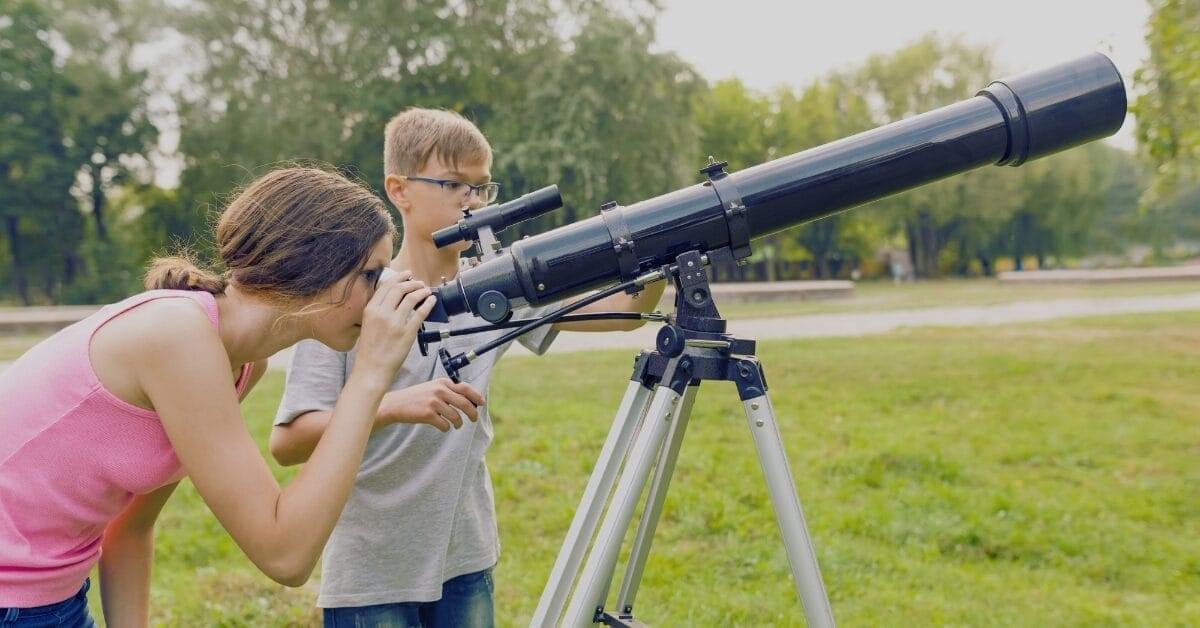What is the best telescope for 10 years old
You want to explore the universe closer than before. That is what a telescope does. But out there are many types of telescopes. It is easier to choose one with a recommendation. So, we are here to help you select your child’s first telescope.
When you grow up, you need a superpower to visit the planet and moons, but a controlled starship (telescope) is perfect for you. The telescope is like the window in your backyard sky to observe the stars, moons, and distant galaxies twinkling like diamonds. Watching stars in the dark sky with your homies will be fun. In this guide, we share a list of the best telescopes for 10-year-olds and the factors before choosing the best telescope. Stay with us for a complete guide to selecting the first telescope.
Types of Telescopes
There are three main types of telescopes.
Refractors:
These telescopes use lenses to bend the light rays and focus them. They are giving you a sharp and bright image.
Reflectors:
These telescopes use mirrors to bend and reflect the light into your eye. Create detailed, bright images.
Compound Telescopes:
Both mirrors and lenses are used in compound telescopes for better views. This type of telescope is best for detailed observation.
What to consider when choosing a telescope for a 10-year-old
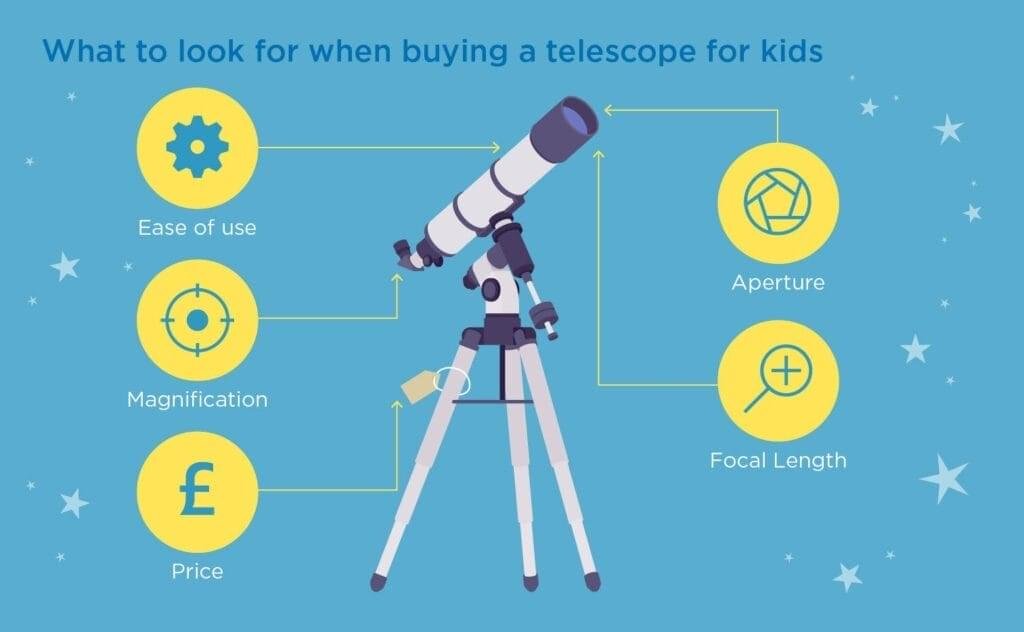
There are important factors you must consider before picking the best telescope for the 10th birthday of your child.
Magnification:
Magnification is seeing a small object at a large scale without missing a single detail. For newbies, the best magnification is 30x to 50x.
Focal Length:
How long light enters a telescope is called the focal length of the telescope. The higher the focal length, the higher the magnification. A shorter focal length of around 300mm to 400mm is best for beginners.
Aperture:
This is the telescope’s opening through which light enters the telescope. A bigger aperture means bright and clearer images, but also with a bigger and heavier telescope.
Mount:
A mount is a structure that provides support to the telescope. You need one that is stable and easy to move. It is very necessary for observations. It helps keep the telescope steady, reducing vibrations and allowing for clearer observations.
Eyepiece:
The lens close to the eye is called the eyepiece of a telescope. I am showing you the images. Different eyepieces offer different magnification.
Size and Weight:
Size and weight always matter. It would help if you had a telescope that you could easily carry up anywhere.
Finder scope
Suppose you have picked your telescope. Let’s talk about its partner finder scope. It helps you to find tiny objects in the dark sky. You can align your telescope accordingly. It quickly locates objects, saving you time and frustration.
Different finder scope types:
Red Dot finderscopes: It is the most common type of finderscope. Use the red dot to guide you.
Right-angled finderscopes: these finderscopes offer a magnified view through a small eyepiece. Making it easy to find the fainter object
Straight-through finderscopes: these work as a mini refractor telescope with a wider field of view. It helps you to find faint objects in the dark sky.
Reviews and recommendations for selecting telescopes for young
Celestron AstroMaster 70AZ: Perfect For Beginners
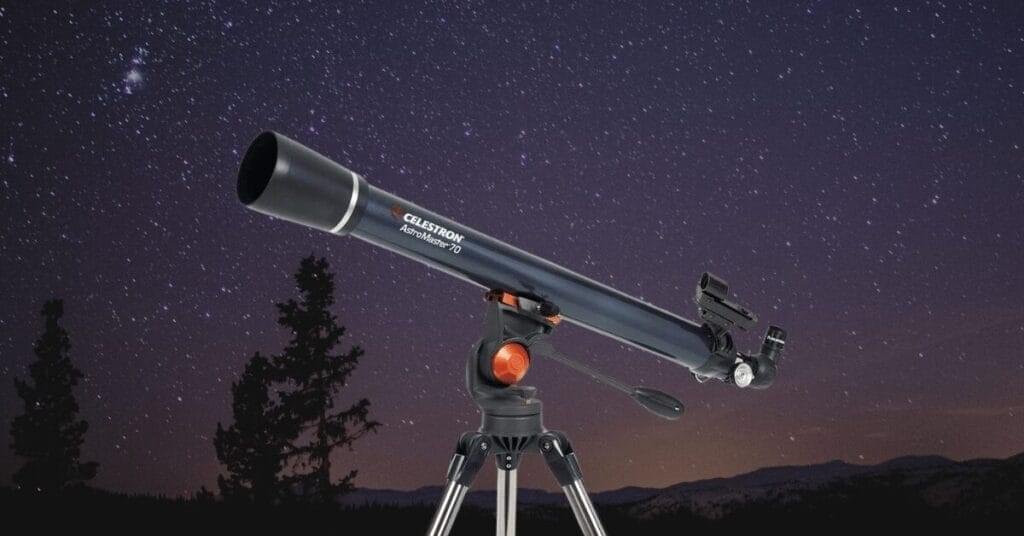
Specs
| Optical design | Refractor |
| Mount type | Alt-azimuth |
| Aperture | 70mm (2.8 inches) |
| Focal length | 400mm (15.7 inches) |
| Focal ratio | f/5.7 |
| Eyepieces included | 20mm and 10mm |
| Highest practical magnification | 160x |
| Weight | 11.4 pounds (5.2 kg) |
Pros:
- Easy to set up and use
- Affordable
- Good views of the Moon, planets, and some brighter deep-sky objects
- Lightweight and portable
Cons:
- Limited aperture
- Alt-azimuth mount can make it difficult to track objects for long periods
- Image quality can be soft at higher magnifications
The Celestron AstroMaster 70AZ is a perfect choice for little astronomers with no sky observation experience looking for an easy-to-use telescope. It is suitable for those who want to enjoy the wonders of the Moon, planets, star clusters, and some brighter, deeper sky objects. It comes at a reasonable price. You can easily set it up even if you are a beginner; it is easy to use. It comes in a decent aperture that gives proper magnification for observation of moon craters. You can easily afford it for your 10-year-old. But this telescope is not good for deep space dives.
Encalife SVBONY 501P 70
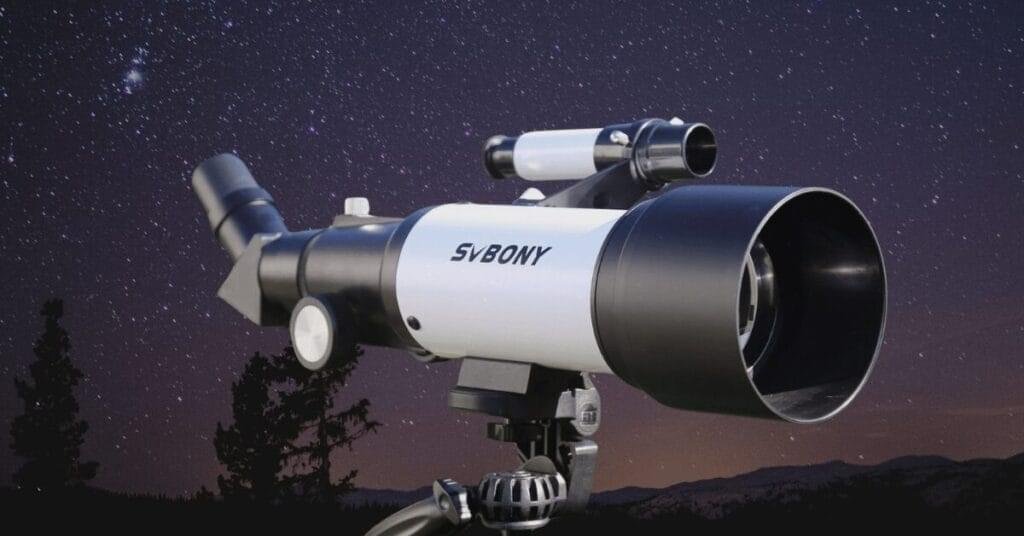
Specs
| Optical design | Refractor |
| Mount type | Alt-azimuth |
| Aperture | 70mm (2.8 inches) |
| Focal length | 700mm (27.6 inches) |
| Focal ratio | f/10 |
| Eyepieces included | 10mm and 20mm |
| Highest practical magnification | 70x (with included eyepieces) |
| Weight | 11.4 pounds (5.2 kg) |
Pros:
- Affordable
- Lightweight and portable
Cons:
- Small aperture size
- Lower magnification
- Low image quality at high magnification.
The SVBONY 501P 70 is an incredibly simple product with a 2.75/70 mm refractor mounted on a small, lightweight tripod. This telescope is made to move and easy to set up. It has a focal length of 400mm, enough to get a good view of the Moon. Very comprises an optical tube with a 5×24 finderscope that attaches to it. A central column can be extended to take it to 50 inches / 127cm. but the tripod reaches 41.5-inch / 105cm as standard
Celestron Astro Fi 102: Best For Young Astronomer
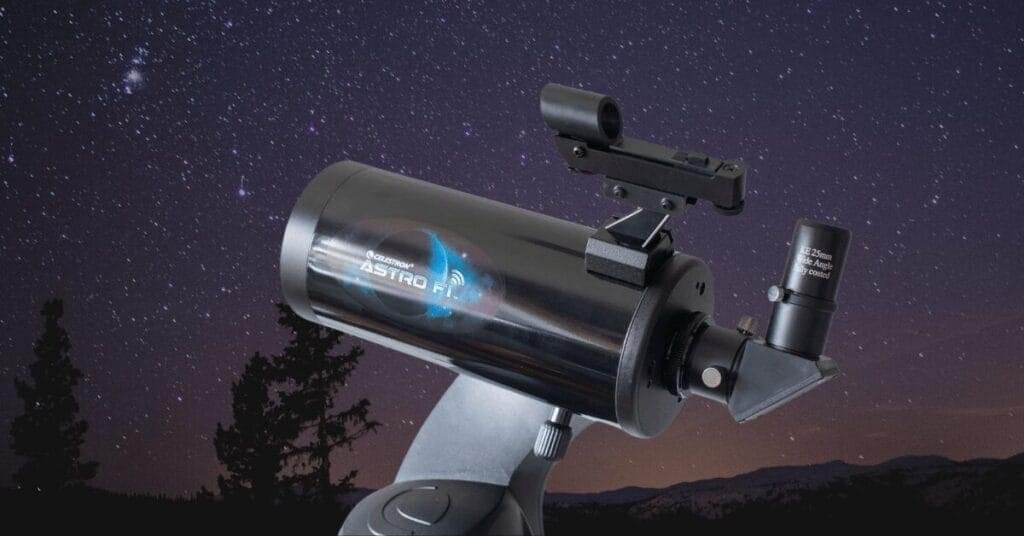
Specs
| Optical design | Refractor |
| Mount type | Alt-azimuth (computerized GoTo) |
| Aperture | 102mm (4 inches) |
| Focal length | 1000mm (39.4 inches) |
| Focal ratio | f/9.8 |
| Eyepieces included | 10mm and 40mm |
| Highest practical magnification | 250x (with included eyepieces) |
| Weight | 26.4 pounds (12 kg) |
Pros:
- Easy to use
- Smart app connectivity
- Automation
Cons:
- Higher price
- Battery life
The motorized Celestron Astro Fi 102 is easy to set and ideal for the little astronomer on the simplest budget looking for a trusted brand telescope. Thanks to its compact body, we can move it from place to place without any hurdles. Wi-Fi enabled telescope. Despite this, we had recommended it as a beginner telescope. This would suit someone interested in observing nights without learning to navigate the sky themselves.
Similarly, we had recommended this telescope to those without the desire to push their cosmos knowledge beyond the basics. As the opportunity for this, the Astro Fi 102 is limited. That is why we added this telescope to our beginner’s telescope list.
Celestron StarSense Explorer DX 130AZ: Best For Night Sky
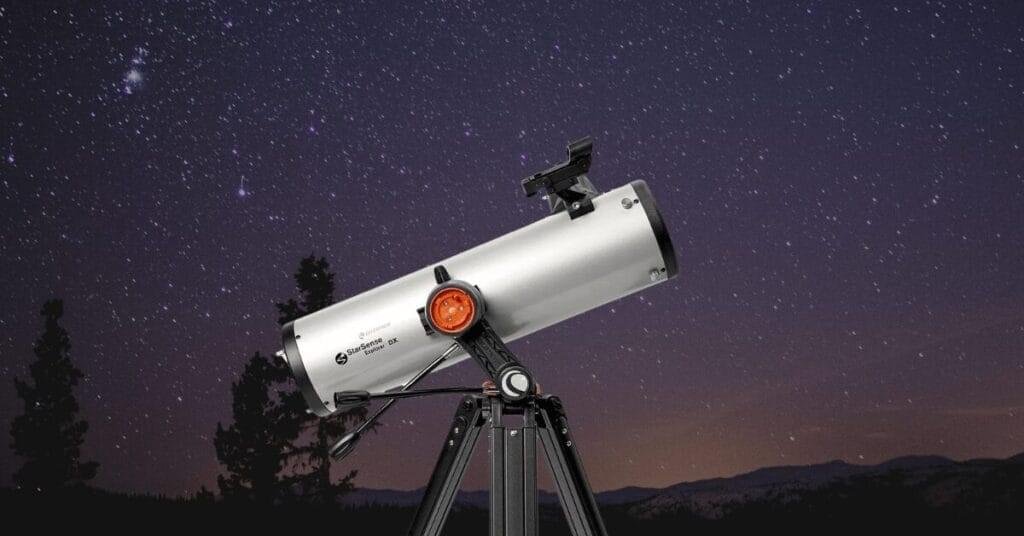
Specs
| Optical design | Newtonian reflector |
| Mount type | Alt-azimuth |
| Aperture | 130mm (5.1 inches) |
| Focal length | 650mm (25.59 inches) |
| Focal ratio | f/5 |
| Eyepieces included | 25mm and 10mm |
| Highest practical magnification | 307x (with included eyepieces) |
| Weight | 18 pounds (8.16 kg) |
Pros:
- Portable and easy to set up
- Large aperture
- Unique StarSense technology
Cons:
- Battery life
- Bulky to carry
You are looking for an interactive and incredible telescope for your 10-year-old kid. Celestron will find you with the StarSense Explorer DX 130AZ Reflector Telescope! The Explorer app helps your stargazing section to the next level. You can observe your favorite celestial object in the dark sky with your personal tour guide.
The Celestron StarSense Explorer DX 130AZ Reflector is perfect for little or amateur astronomers who want to start their cosmos journey. The Explorer app helps you in finding space in a breeze. By syncing, your smartphone to your telescope with Starsensedock, the the Celestron Explorer app knows where your telescope is pointing and gives you precise instructions on where to aim your telescope to center the celestial object into the eyepiece. Thanks to the Celestron Explorer app, I am taking professional-level ideas and putting them in the palm of little astronomers.
Nasa Lunar: Telescope for Kids
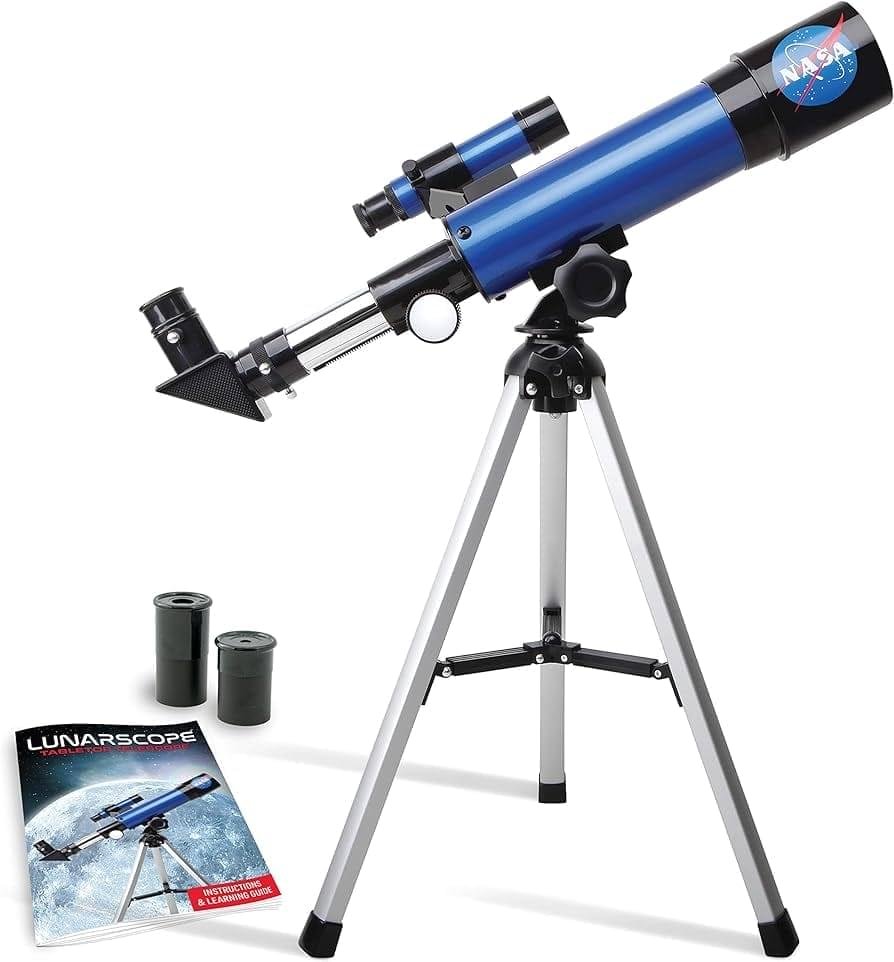
Specs
| Optical design | Refractor |
| Eye Piece Lens | Galilean |
| Telescope Mount | Equatorial Mount |
| Focus Type | Manual Focus |
| Magnification | 90x |
| Brand | Dr. Cool |
| Objective Lens | 1 KB |
Pros
- Low price
- Easy to use
Cons
- Limited magnification
- Plastic construction
If you are looking for a trusted brand telescope for your 10 years, then the NASA lunar 90x telescope for kids is the perfect choice. NASA is a well-known brand for space observation in the world. NASA telescope allows you to see the Moon in complete detail. It is the perfect gift for girls or boys interested in space, Moon, and astronomy.
This is an easy-to-use telescope with a finderscope low and high-power eyepiece with a smooth mounting system that scans the entire lunar surface easily. It uses a tripod to steady your lunar 90x telescope for optimal viewing. You and your child will love this lunar 90x telescope.
FAQS
What makes a telescope good for your 10-year-old?
Choosing the right telescope depends on what you want to observe. If you are a beginner then a simple refractor telescope with 50x to 100x magnification, lightweight telescope is best for you.
What’s the best telescope for the whole family?
While the best telescope for children is completely functional, the whole family can observe the celestial object with these telescopes. If your budget is higher, you can pick another telescope with more abilities.
How do I choose a telescope for my child?
If you are choosing a telescope for your child, you must consider these factors: Your budget, magnification, weight, aperture size, Durability, and portability of the telescope.

